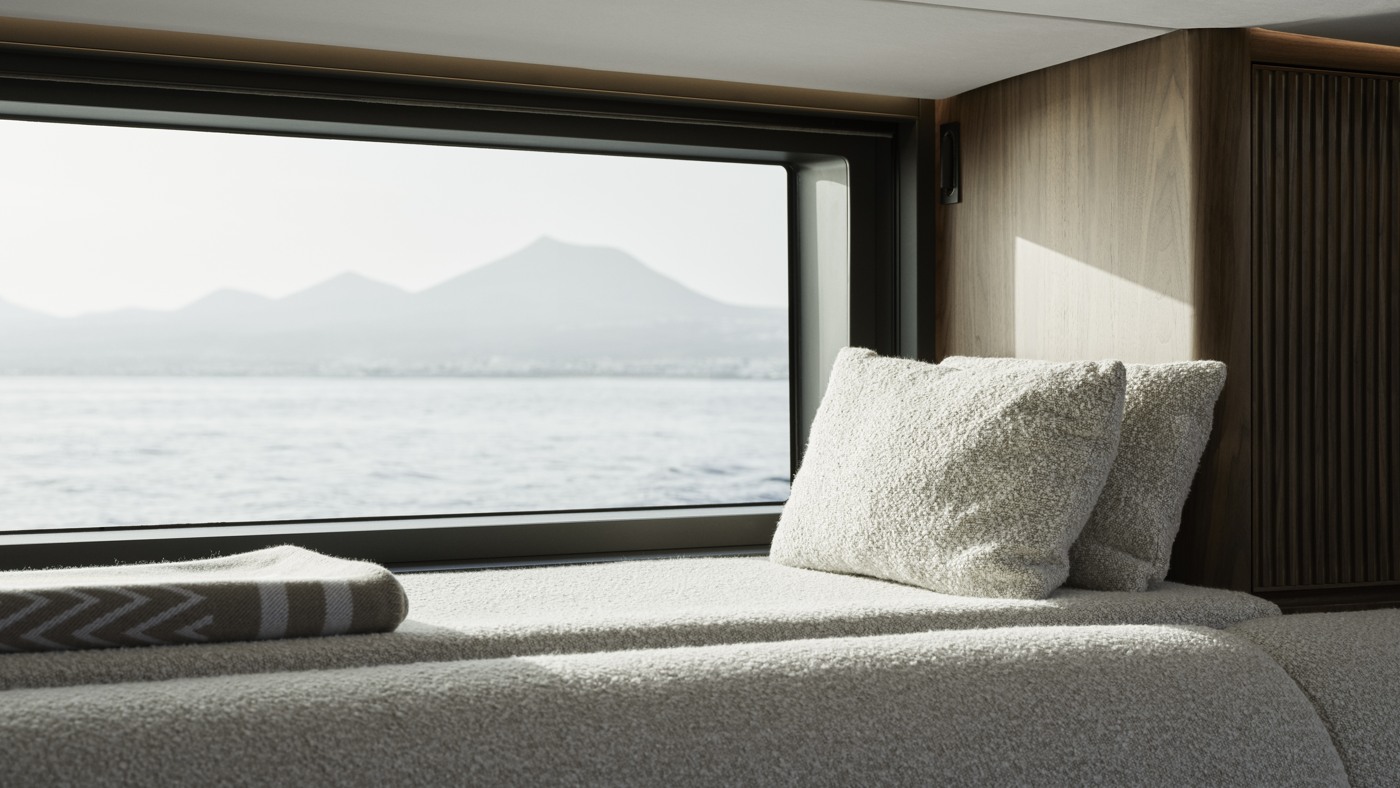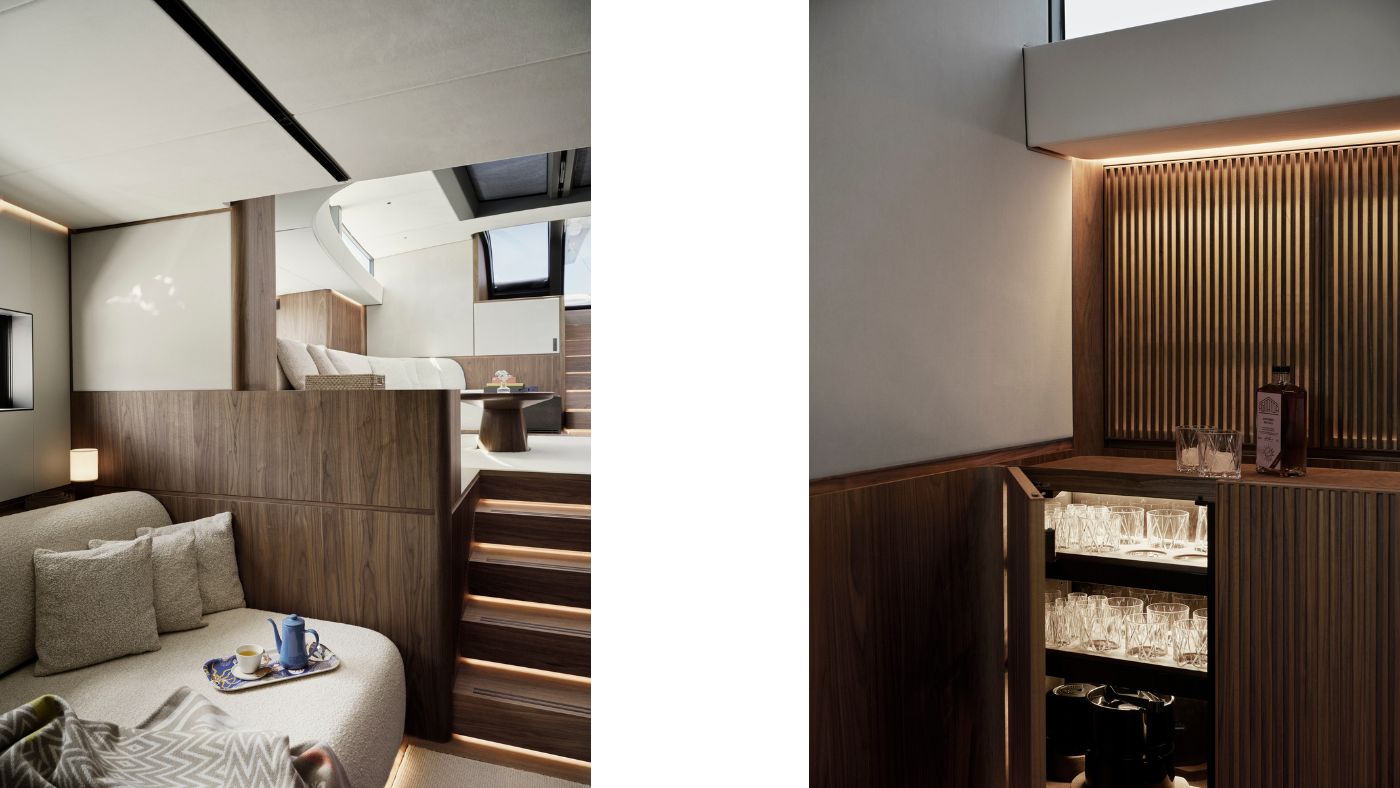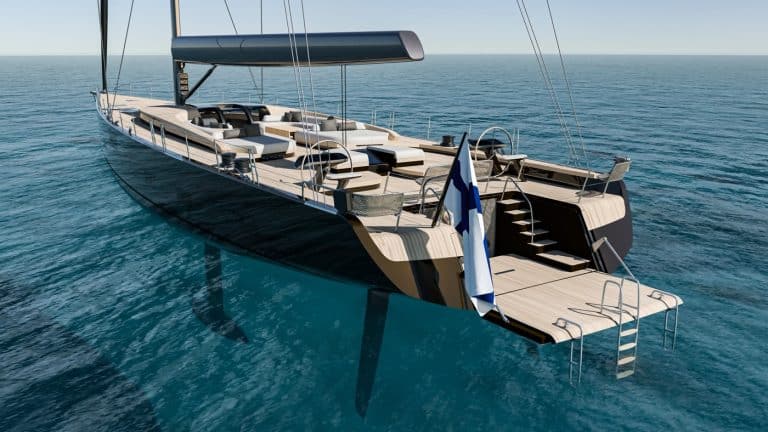
TIDE MAGAZINE: FROM LAND TO SEA
5 March 2024
Featuring a contemporary, warm and crafted look by Swedish architects Andreas Martin-Löf Arkitekter, the 34m sailing yacht ZEMI is a fine example of how shore-side designers can adapt to create stunning, boundary-pushing yacht interiors
Forward-thinking shipyards and owners are becoming increasingly creative and inviting designers from outside the yachting industry to make their mark on board. One such example is Swedish architectural firm Andreas Martin-Löf Arkitekter. Well-known for its high-end residential projects, the Stockholm-based design firm has more recently also turned its hand to a few yacht interiors, including Baltic’s latest delivery, ZEMI.
“One of the key skills that I believe I brought to the table was my experience with high-end residential design,” says Andreas. “As a designer, I have a keen eye for detail and understand how to create spaces that are both functional and beautiful.” In fact, Andreas’s background in interior architecture and furniture design allowed him to bring authority and consistency to the process. “Instead of creating problems, I used my knowledge in architecture to solve them.”
Andreas describes ZEMI’s interior as welcoming, elegant, minimal and crafted. Not only are these his signature values, they are also what was discussed when Andreas first met with ZEMI’s owner and family. “We talked about what we believe are the qualities that make a warm home away from home, and overlaid these with an understated sophistication,” explains Andreas. “The results of this initial conversation really guided the whole design process, from start to finish.”

Transitioning from large-scale, land-based properties to the high seas is no easy feat, but the entire build team from both Baltic Yachts and ZEMI’s naval architect Malcolm McKeon worked closely with Andreas and his design staff to help them overcome the unique limitations that a yacht’s interior can have. “Designing the space on board a yacht brings with it a number of key differences to residential interiors – be it headroom, utilities and services, a distinction between guest and crew spaces, the literal shape of the yacht and the need to blend interior and exterior areas into one whole,” explains Andreas. “These issues all require a great deal of skill and experience, which fortunately I have been able to translate from my previous architectural projects, as well as from the design of my own personal yacht.”
To adapt, first Andreas gained a better understanding on how a sailing yacht such as ZEMI behaves during an Atlantic crossing, for example, and the issues of balance and stability. This was even more important given that her experienced owner intends to use the sloop-rigged sailing yacht to cross oceans and cruise around the world with his family. Andreas also had to factor in the weight of the materials used. “I must admit, it gets more interesting and complex when you start to understand more about the advanced technology on board a yacht like ZEMI,”says Andreas.
The quality of a Superyacht’s interior is incomparable – or at least it should be. “The use of high-quality materials is essential as they need to be both stylish, functional and able to withstand the harsh marine environment,” says Andreas. “One of the more challenging aspects of a sailing yacht of this size and type is that all of the interior panels and parts need to be low weight and removable, while still retaining a high quality and solid feel.” Fortunately, all in the naval team at Andreas Martin-Löf Arkitekter have a good understanding of materials and finishes and how to use them to create cohesive and smart spaces. ZEMI features warm walnut and limestone panelling for the solid feel, which are bonded usingveneers to lightweight honeycomb structures. This weight-saving technique continues throughout her interior, with bathroom surfaces also created using veneers of limestone bonded to lightweight carcasses.

Another area in which shoreside designers excel is their understanding of how a space is lived in, familiar as they are with designing residential interiors that have both form and function. However, the proportions and scales of a yacht are quite different, as is the space required for the yacht’s systems, all of which need to be accommodated into the background, along, of course, with safety and security considerations. Andreas worked closely with the Baltic shipyard, learning not only about all the practicalities of the yacht’s movement and stability, but also how to be clever with space and use every square inch available. “We incorporated even the air- conditioning outlets into the design to create the sleekest visual look possible throughout ZEMI’s interior guest areas,” explains Andreas. “We worked to refine the lighting systems to be less obtrusive.” The four cupboards with Japanese-style lantern doors in the saloon are custom designed by Andreas, as well as the wall sconces and bedside lamps which were handmade in a small lighting factory in Sweden. “These are just a couple of examples of the thousands of service elements that need to be incorporated and hidden in the background of a yacht’s interior,”says Andreas.
Then there is the relationship between the interior and exterior deck areas. “Many comparable yachts do not have an open and inviting connection between the interior and exterior guest areas,
and this is a connection that was important for the owner,” explains Andreas. With residential projects, the interior is often designed in conjunction with its surroundings, but a yacht’s view can change from a built-up marina to a never-ending horizon, and the designer also needs to consider these varying outlooks into every vantage point on board. “Consistency is an important element that often guides the work we do in the AML studio,” says Andreas. “I like cohesive design and spaces which flow seamlessly from one to another, whether this is from the main saloon to the guest accommodation or outside to the
exterior deck areas.”
Andreas and his team managed to translate aesthetic ideas used in their upscale residential designs into ZEMI’s interior, adapting them to suit the specific needs of the owner. “Yacht interiors, especially sailing yachts, so often veer towards the traditional, but instead of looking backwards towards nostalgic sailing yacht design, my team, together with Malcolm McKeon, went for the more contemporary, and perhaps slightly minimalist style, that originally caught the owner’s eye in our residential projects,” says Andreas. “That said, our land-based projects are often contemporary in their design but with a nod to their heritage, and there are a few areas on board ZEMI where we have incorporated traditional sailing yacht features. One example is the design of the sleek superstructure with its sharp, straight and low 180-degree window – the shape refers to a traditional wheelhouse.”
In the case of ZEMI, the crossover approach of a land-based architect and an experienced yacht build team both challenged and pushed the design boundaries, and the resulting Baltic sailing yacht has certainly raised the bar. “With ZEMI I think we have successfully combined the requirements of a performance sailing yacht with [those of a home] in an elegant and understated design,” says Andreas. Judging from the resulting build, it seems that diversifying into yacht interiors may have been a very good move for Andreas and his team.
As published in TIDE Magazine nr. 6 2023
WORDS: MIRIAM CAIN
IMAGES: KRISTOFER JONSSON
LEARN MORE

BALTIC 110 CUSTOM FEATURED IN SEAHORSE MAGAZINE
The latest collaboration between Baltic Yachts and Malcolm McKeon Yacht Design puts equal emphasis on performance, elegance, efficiency and easy...
MORE
BALTIC 110 ZEMI IS CHRISTENED BY HER OWNERS AS SHE TAKES TO THE WATER FOR THE FIRST TIME IN JAKOBSTAD
A two-year build period culminated in the naming and launching of the Baltic 110 Zemi in Finland last week when...
MORE